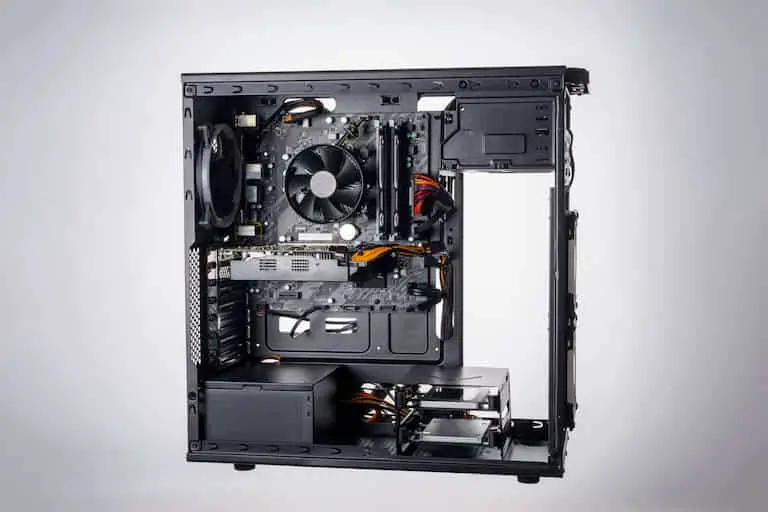Having a fan on your computer is a must—all those inner workings generate heat, and too much of it can fry your rig. Custom builders often add aesthetic flair to their PCs, and one way they do that is with RGB fans. They look cool (and cool), but they’re also another thing that can go wrong. RGB fan not lighting up? No problem, this is how to fix it.
Here are five ways to fix an RGB fan that’s not lighting up:
- Make sure the fan has enough power.
- Find out if your RGB fan requires a separate controller.
- Check that your motherboard or GPU supports the fan.
- Update or reinstall the fan’s drivers
- Adjust your BIOS settings.
RGB lighting isn’t necessary for your fans to work, but it’s a neat feature and one you paid extra money for. After reading this article, you should be able to go back to gaming with all of your ambient lights working properly.

Make Sure the Fan Has Enough Power
If you’re comfortable taking the cover off your computer, this will likely be an easy fix. Some RGB fans have two plugs—one to power the fan and another to power and control the RGB lighting. Your problem may just be that the second plug isn’t attached to anything.
With the case open, locate the fan and follow its cables. If there are two coming from the fan and one cable isn’t connected to anything, there’s your problem. Find an open SATA or Molex plug—or whatever other kind of plug might be on the fan—and connect the cable to it.
Barring any other problems with the fan, you should be all set. Of course, if the fan isn’t spinning in the first place, you might be facing a different issue.
Find Out if Your RGB Fan Requires a Separate Controller
One problem you could run into while looking for an open plug is a proprietary plug. Not all RGB fans use the same connectors. Your fan may require a separate controller. If it does, it most likely came with the controller included, but if you forget to hook it up (or didn’t know you had to), you’ll have no way to power the fan.
Although this is not the most common cause of why your fan spins but doesn’t light up, it’s still worth mentioning, especially because it’s very easy to check.
If your fan requires a separate controller, you’ll need to connect it to a USB 2.0 header on your motherboard. If you don’t have an open one, you’ll need a splitter like the Nest Warehouse 9-Pin USB Header Splitter (available through Amazon.com). Its wired belt shielding ensures that the connection remains stable.
Once you attach the controller and plug the light cable into it, your fan should spin and light up as usual.
Check That Your Motherboard or GPU Supports the Fan
Some RGB fans don’t connect to the motherboard but are instead plugged into the graphics card.
For instance, if your motherboard has only a 12V RGB header, but you have an aRGB fan, they won’t match. The aRGB plug will have an extra pin, so you can visually identify it. RGB and aRGB are pretty similar, but aRGB (addressable Red Green Blue) is more advanced and will allow for more color options and patterns.
At any rate, you can find your motherboard’s make and model, then check it against an RGB fan’s specs before you mistakenly buy the wrong one.
Update or Reinstall the Fan’s Drivers
Most of us have had some experience with drivers not working like they’re supposed to. Sometimes they’re out of date, and sometimes they just need to be reinstalled.
If your RGB fan is spinning but not lighting up, and you know it’s hooked up properly and has all its power needs met, the issue could be driver-related.
Here’s how to update your fan’s driver:
- Click the Start button and type “Device Manager,” then press Enter.
- Find the RGB fan on the list of devices and click it.
- Right-click on the driver you want to remove and click on “Update”.
- Restart your computer.
If Windows tells you the driver is up to date or it simply doesn’t fix the issue, you can move on to manually updating the driver.
Visit the website of your RBG fan’s manufacturer and look for a list of drivers. Download the latest version that’s compatible with your system and install it. You may need to restart your computer before changes take effect.
Adjust Your BIOS Settings
If you’re not tech-savvy, you may want to ask someone more knowledgeable in computers to help you. If you’ve tried all the steps above and still have no lights from your RGB fan, it’s time to explore the BIOS settings.
- Press and hold the Windows key, then press R.
- In the “Run” window that comes up, type this:
%temp%
- This will open a window with all your temporary files and folders. Select and delete all of them.
- Restart your computer.
- While it’s restarting, press the “Del” key repeatedly. This will open BIOS settings.
- Click on “Advanced Mode.”
- In the new window, click on “QFan Control.”
- Click on “CHA Fan” under “Optimize All.” A new set of options will appear.
- Look for any options that might be causing a problem with your fans. Make the necessary changes and hit “Apply.”
- Exit, save changes, and restart your computer.
Key Takeaways
Your RGB fan can add sweet effects to your rig, but building or customizing a PC always comes with the risk of running into things not working as they should.
The good news is that, if the lights on your RGB fan aren’t working, chances are you just need to check the connections. If that doesn’t work, you may have forgotten to install the fan’s drivers when you first installed it.
If that doesn’t work either, then you may have a hardware issue on your hands.







